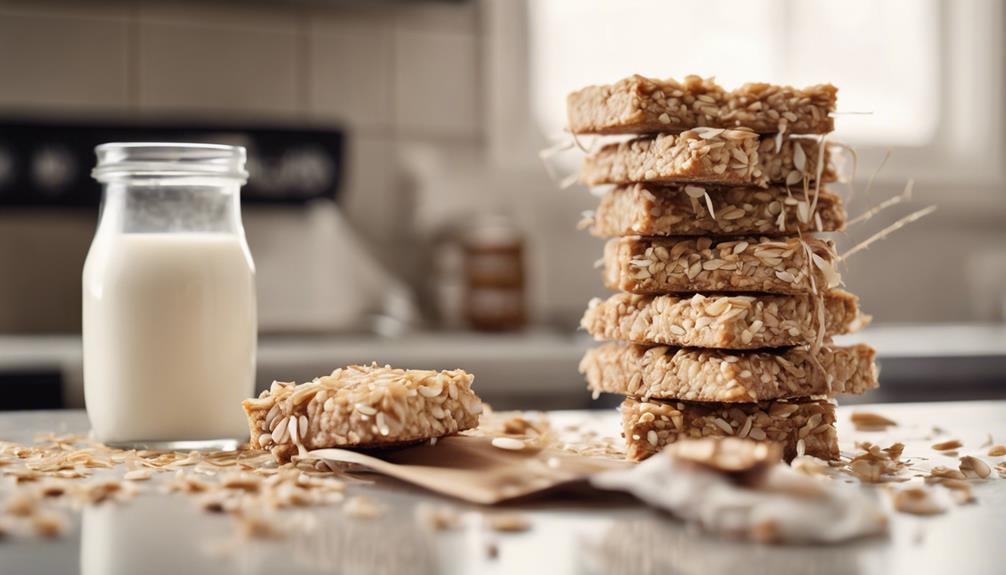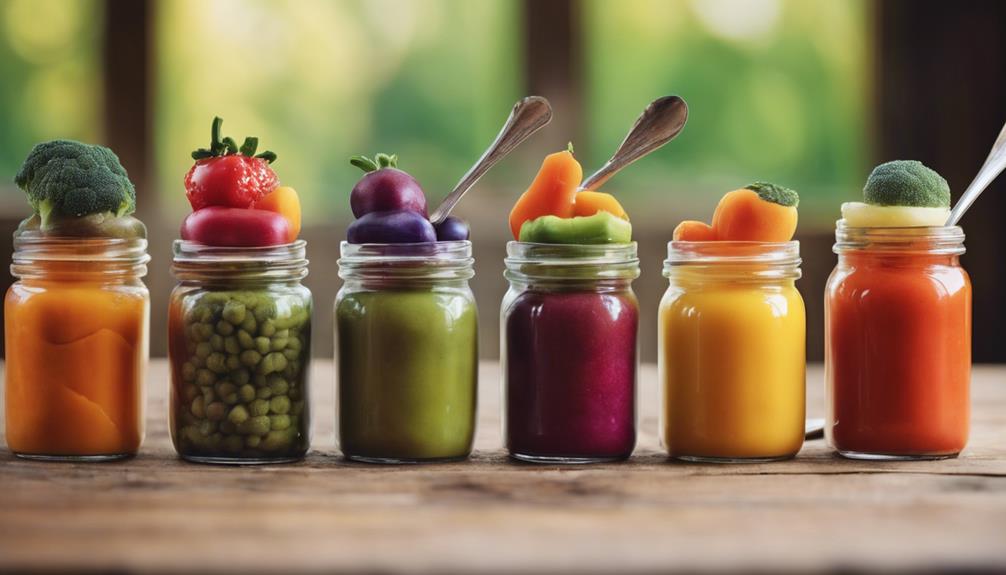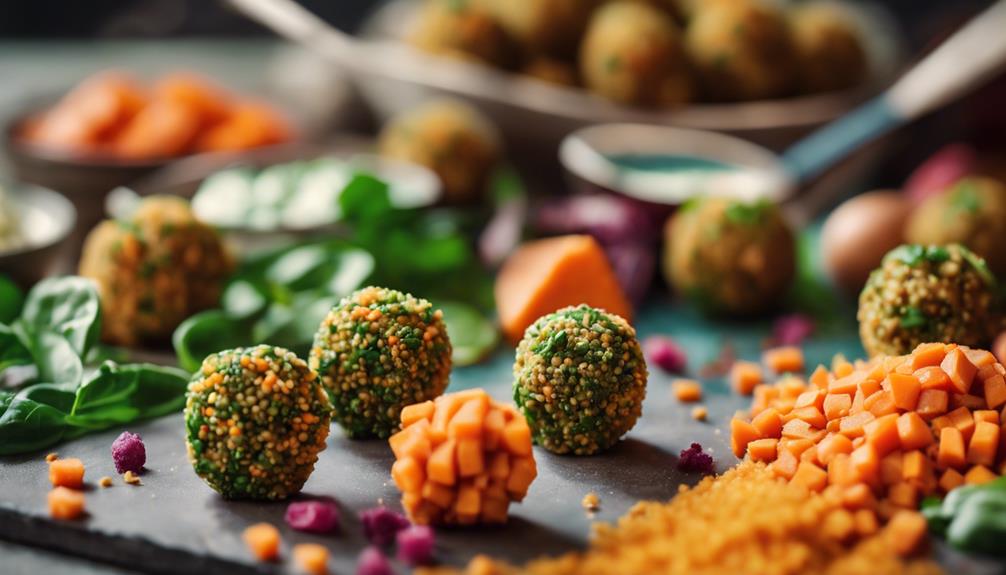When starting your baby on zucchini puree, you're providing a nutrient-packed first food. It contains essential vitamins such as A, C, B6, and potassium. Opt for small to medium zucchinis with smooth skin and vibrant color for the best taste. Steam zucchinis until soft, then mash or puree for a smooth texture. Enhance the flavor with herbs and spices like basil or garlic. Try mixing with corn, peas, or eggplant for varied tastes. Boil zucchinis until very soft, puree, cool, and freeze in cube trays for later. This nutritious option is versatile and supports your baby's health.
Key Takeaways
- Zucchini puree is rich in essential nutrients like vitamins A, C, B6, and potassium, ideal for baby's health.
- Smooth consistency aids in easier swallowing due to high water content, perfect for baby's first food.
- Freezing capability allows for convenient meal prep and storage, ensuring freshness and easy portioning.
- Versatile base for creating nutritious baby food with endless combinations like herbs, spices, and other ingredients.
- Provides hydration, fiber, and immune support with vitamins A, C, B6, aiding in healthy digestion and overall health for babies.
Reasons to Love Zucchini Puree
With its thin texture and nutrient-rich profile, zucchini puree is a fantastic choice for introducing your baby to solid foods. Great baby food, zucchini offers a delicate flavor that's well-received by little ones and can be easily paired with various ingredients.
Zucchinis are packed with essential vitamins and minerals like vitamin A, C, B6, and potassium, making them a nutritious option for your baby's diet.
One of the advantages of zucchini puree is its high water content, which creates a smooth consistency that aids in easier swallowing for babies who are just starting on solids. Additionally, zucchini puree can be frozen, allowing for convenient meal prep and storage.
This puree also works well for thinning out thicker vegetable or meat purees, providing a balanced and easily digestible meal for your little one.
Ingredient Information and Tips
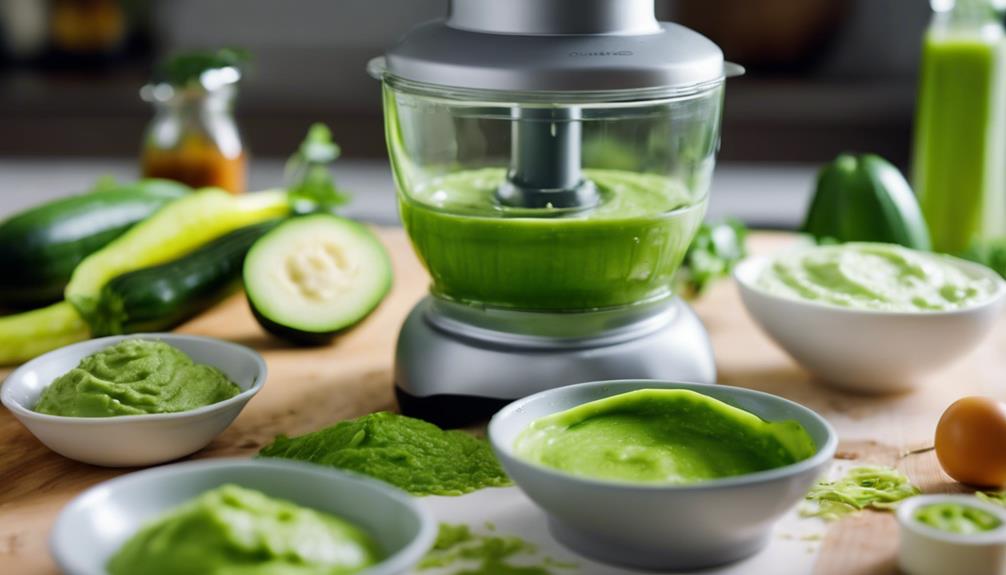
When preparing zucchini puree for your baby, it's essential to select small to medium-sized zucchinis with smooth skin and no blemishes.
These zucchinis are rich in essential nutrients like vitamins A, C, B6, and potassium, supporting your baby's development.
Remember to store unwashed zucchinis in the refrigerator's vegetable drawer to maintain their freshness for your baby's meals.
Ingredient Selection
For the finest zucchini puree, prioritize selecting small to medium zucchinis with smooth skin and no imperfections to guarantee the best taste and texture.
Look for small to medium zucchinis: These sizes are ideal for zucchini baby food as they tend to be more tender and have a milder flavor.
Check for smooth skin: Smooth skin indicates freshness and will contribute to a smoother texture in the baby puree.
Avoid zucchinis with imperfections: Imperfections can affect the taste and texture of the puree, so opt for flawless zucchinis for a better end result.
Ensure freshness: Select zucchinis that feel firm to the touch and have a vibrant green color as these are signs of freshness and peak taste.
Storage Recommendations
To maintain your zucchinis stay fresh and flavorful for making baby puree, proper storage is key in maintaining their quality.
Store zucchinis in the refrigerator's vegetable drawer unwashed to prevent excess moisture, which can lead to premature spoilage.
Opt for small to medium-sized zucchinis as they offer better flavor and texture in purees.
When preparing zucchini puree for your baby, consider freezing it in ice cube trays for convenient meal prep and portion control.
Avoid wrapping zucchinis in plastic bags, as this can impact their freshness. Instead, place them in a breathable container or a perforated plastic bag to allow for proper air circulation.
If you plan to freeze the zucchini puree, transfer it to a freezer bag, making sure to remove any excess air before sealing.
Remember that zucchini's high water content contributes to a thin texture, making it easier for babies to swallow.
Choosing and Storing Zucchini

To ensure the best flavor and texture in your zucchini puree for your baby, select small to medium-sized zucchinis with smooth skin and no blemishes. When it comes to choosing and storing zucchinis, follow these tips:
- Pick Wisely: Choose small to medium-sized zucchinis with unblemished, smooth skin to achieve the best taste and texture in your baby's puree.
- Storage Matters: Keep unwashed zucchinis in the refrigerator's vegetable drawer to maintain freshness by preventing excess moisture buildup.
- Year-Round Availability: Zucchinis are an excellent choice for baby food since they're available throughout the year and can be quickly cooked to prepare nutritious meals.
- Avoid Plastic: Avoid wrapping zucchinis in plastic bags as this can lead to spoilage; instead, store them loose in the fridge to preserve their quality.
Zucchinis, with their high water content, are perfect for creating a thin puree texture that's easy for babies to swallow.
Process Shots and Cooking Tips
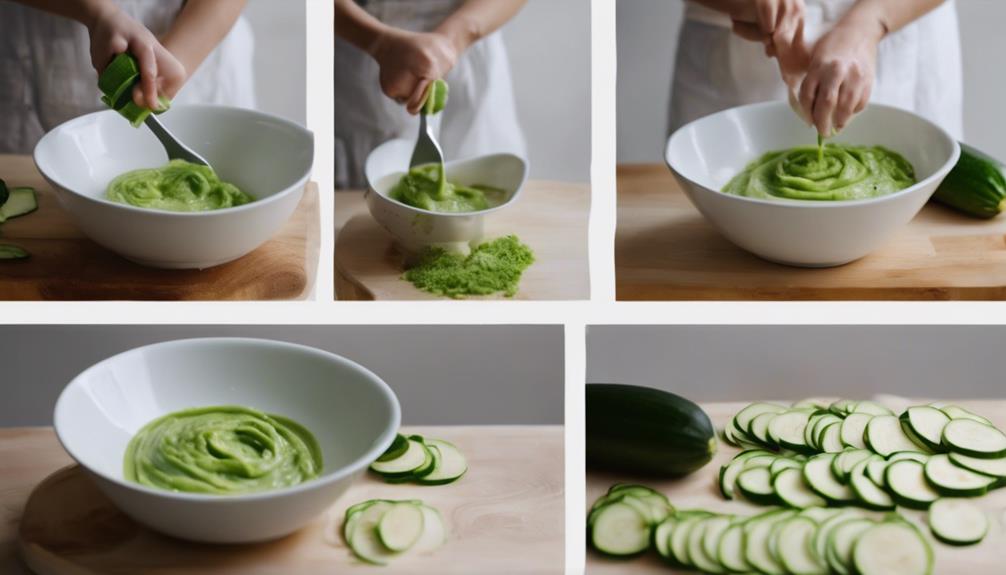
When preparing zucchini puree for your baby, consider employing various recipe preparation techniques such as steaming the zucchini until soft and tender.
These methods guarantee a smooth texture that aids in the switch to solid foods.
Including visual step-by-step instructions and cooking tips can be highly beneficial for creating a successful zucchini puree for your little one.
Recipe Preparation Techniques
For achieving a smooth texture in your zucchini puree, steam the zucchini until soft and tender for about 8-10 minutes.
Once the zucchini is cooked, follow these steps to prepare a nutritious zucchini puree for your baby:
- Mash or puree the steamed zucchini to create a smooth consistency suitable for babies starting on solid foods.
- Experiment with adding herbs and spices like basil, garlic, or lemon to introduce varied flavors to the zucchini puree.
- Utilize a food processor or blender to achieve a finer texture, ensuring the puree is easy for your baby to consume.
- Consider combining zucchini with other ingredients like corn, peas, eggplant, or lentils to create diverse baby food options that are both nutritious and delicious.
Zucchini's mild taste and versatile nature make it an excellent base for various puree combinations, allowing you to explore different flavor profiles and introduce your baby to a wide range of ingredients through baby-led weaning.
Cooking Tips
To capture the process visually, consider capturing process shots of the zucchini steaming and being blended to create a smooth puree texture for your baby.
When cooking zucchini for pureeing, steam it until soft and tender for approximately 8-10 minutes. This ensures that the zucchini will be easy to mash or blend into a creamy texture suitable for babies shifting to solid foods.
To elevate the flavor profile of the zucchini puree, experiment with adding herbs and spices like basil, garlic, lemon, or parsley. These additions can enhance the overall taste and introduce new sensory experiences to your baby.
Zucchini's mild taste makes it a versatile base for creating different puree combinations, allowing you to mix it with ingredients such as corn, peas, eggplant, or chicken for varied and nutritious baby food options.
Visual Step-by-Step Instructions
Capture the process visually by steaming and blending zucchini to create a smooth puree texture for your baby. To achieve this, follow these steps:
- Wash and slice the zucchini before steaming it until soft and tender, typically taking 8-10 minutes.
- The high water content of zucchini creates a thin texture, ideal for easier swallowing for babies.
- Puree the zucchini after steaming to introduce texture gradually to babies.
- Experiment with adding basil or other herbs for extra flavor variations in the puree.
Zucchini's delicate flavor and nutrient-rich profile make it an excellent first taste food for babies. By following these simple steps, you can prepare a nutritious and delicious zucchini puree for your little one. Experiment with different herbs and spices to customize the flavor and introduce your baby to a variety of tastes.
Zucchini Puree Combinations
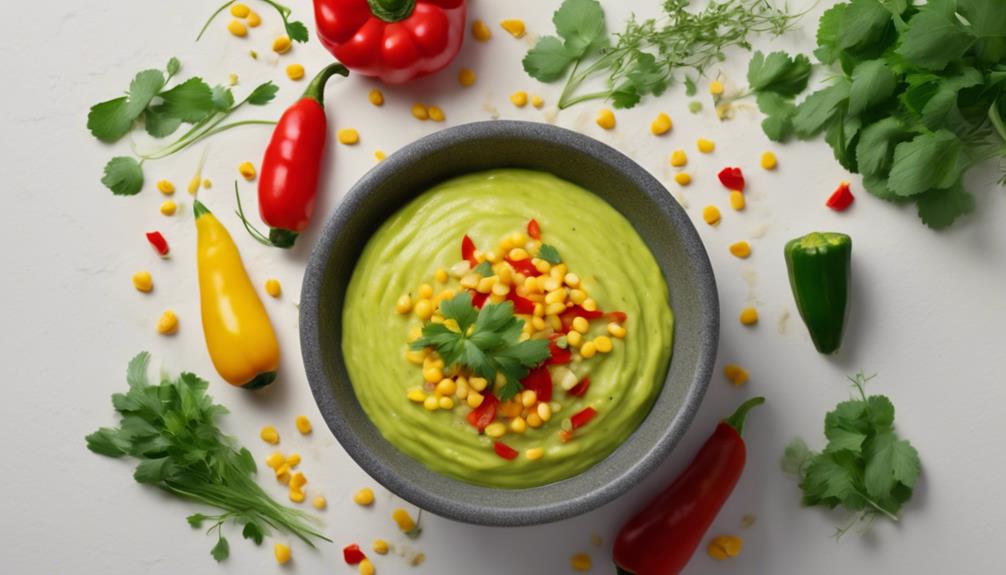
Experiment with zucchini puree combinations to introduce a range of flavors and nutrients to your baby's diet. Zucchini puree serves as a versatile base for creating nutritious baby food by blending it with ingredients like corn, peas, eggplant, and butternut squash.
Enhance the flavor profile of zucchini by adding herbs such as basil, garlic, marjoram, or spices like onion and parsley. The mild taste of zucchini allows for endless combinations, including bell pepper, green beans, lentils, eggs, chicken, and potatoes.
By mixing zucchini with various ingredients, you can introduce new tastes to your baby and offer a diverse range of nutrients. Zucchini puree's compatibility with a variety of flavors makes it an ideal ingredient to mix and match with other purees, ensuring that your baby receives a well-rounded and nutritious diet.
Get creative in the kitchen and explore different zucchini puree combinations to provide your little one with a flavorful and healthy eating experience.
Making Zucchini Baby Food
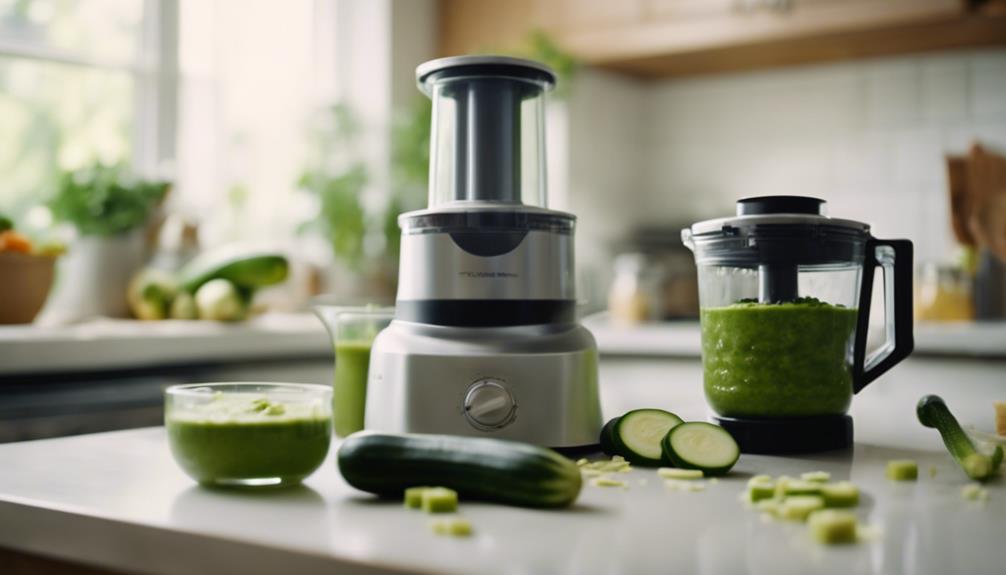
For making zucchini baby food, start by cubing the zucchini and boiling it until very soft, typically for 5 to 10 minutes. Once the zucchini is tender, drain it well and transfer it to a blender or food processor. Purée the zucchini until it reaches a smooth consistency suitable for your baby.
Remember to let the purée cool entirely before offering it to your little one to avoid any burns. To make future feedings more convenient, consider using an ice cube tray.
Here's a simple guide to preparing zucchini baby food:
- Cube the zucchini and boil until very soft.
- Drain and purée the zucchini in a blender or food processor.
- Cool the purée before feeding.
- Portion the purée into an ice cube tray, freeze until solid, and store the frozen cubes in a freezer bag for later use.
Following these steps will help you create nutritious zucchini baby food for your little one to enjoy.
Making Zucchini Baby Food Ahead
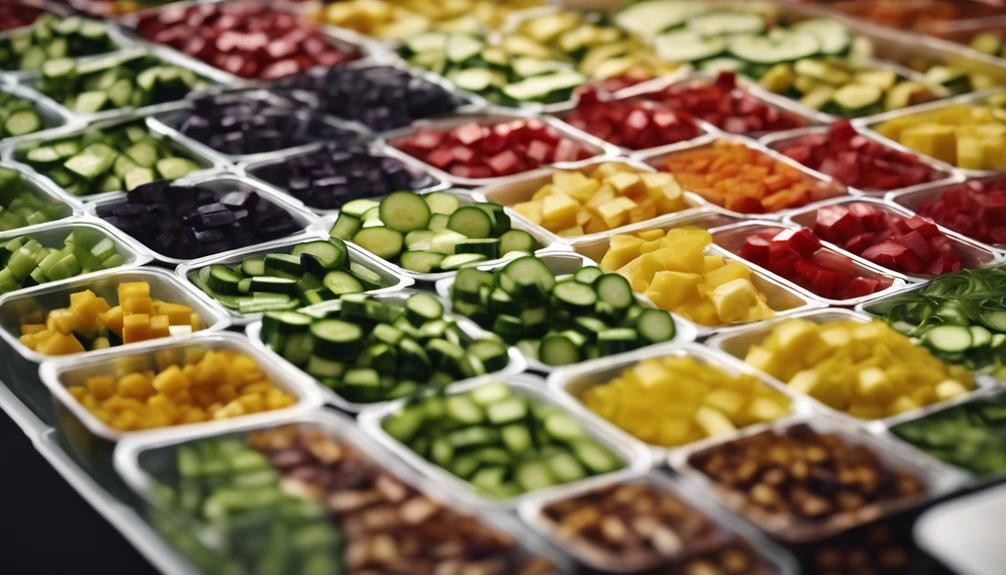
Are you looking to prepare zucchini baby food in advance for added convenience? When making zucchini puree for your little one, consider freezing it for future use.
An efficient method is to fill an ice cube tray with the zucchini puree and freeze it until solid. Once frozen, transfer the zucchini cubes into a freezer bag for easy storage. This approach not only allows for portioning but also extends the shelf life of the baby food.
When you're ready to serve the zucchini puree, simply defrost the desired number of cubes in a microwave-safe bowl. Heat them for around 30 seconds or until they reach the desired temperature.
This freezing technique is perfect for busy parents looking to streamline meal planning and ensure the freshness of their homemade zucchini baby food. By having pre-portioned zucchini cubes readily available in the freezer, you can easily provide your little one with nutritious meals without the hassle of preparing food from scratch every time.
Nutritional Information Details
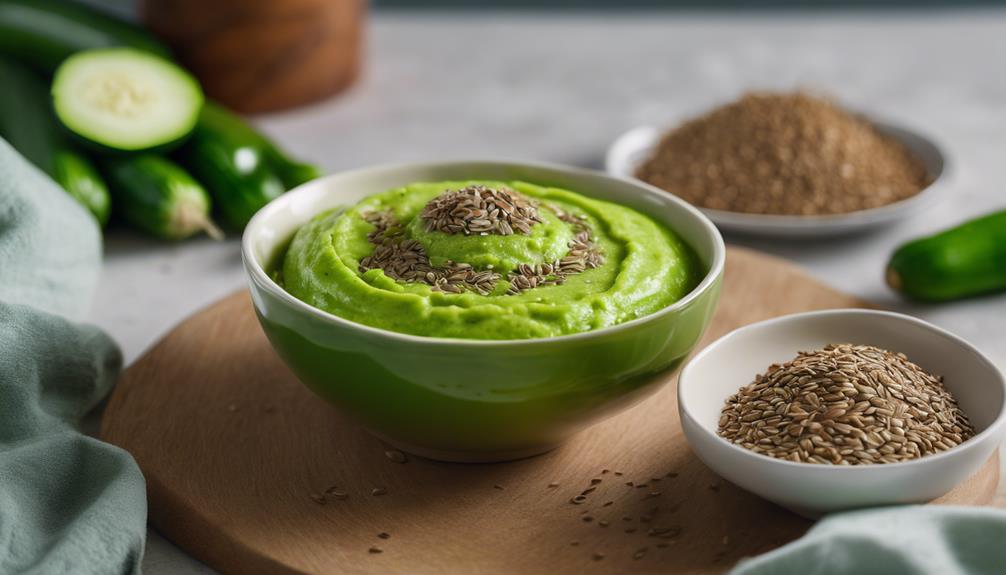
Explore the nutritional benefits of zucchini puree for your baby, emphasizing its essential vitamins and minerals. Zucchini puree, a popular choice for homemade baby food, offers a range of nutrients pivotal for your little one's growth and development.
Here's a breakdown of the nutritional information:
- Rich in essential vitamins like A, C, and B6, zucchini puree supports your baby's immune system and overall health.
- With a high water content, this baby food aids in hydration and easy digestion, making it gentle on your baby's tummy.
- Zucchini puree is a great source of potassium and fiber, promoting healthy digestion and regular bowel movements.
- Versatile and budget-friendly, zucchini puree can be combined with various fruits, vegetables, and proteins to introduce diverse flavors and nutrients to your baby's diet.
Consider adding zucchini puree to your homemade baby food repertoire for a nutritious and well-rounded meal option for your little one.
Privacy Policy and Data Processing
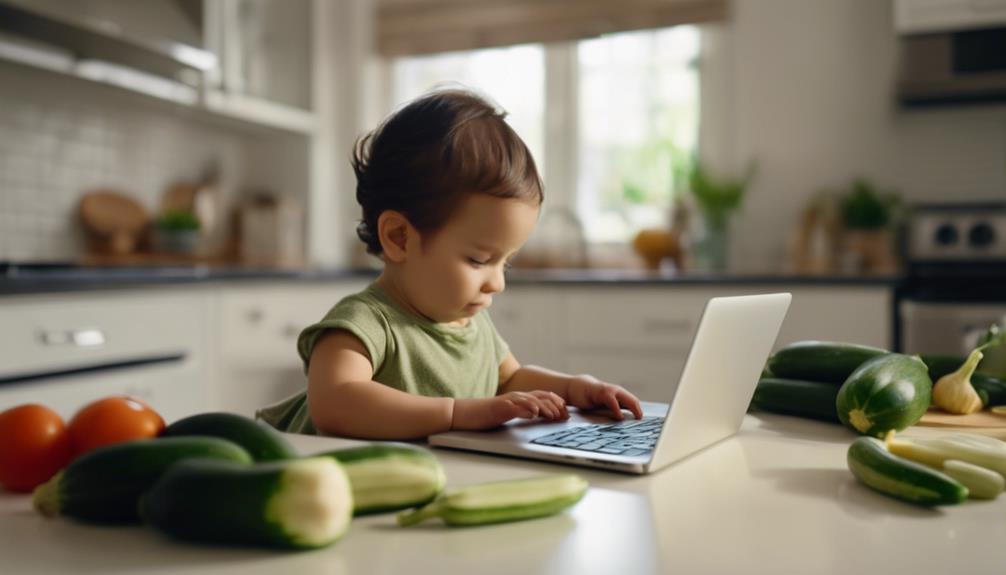
Learn about how Allrecipes and its partners handle privacy and data processing on their platform.
Allrecipes and its partners may store or access information on devices for data processing purposes. Users are granted the ability to manage their privacy choices through the privacy policy page, ensuring transparency and user control over data usage.
Choices made by users regarding privacy settings will be effectively communicated to partners without impacting browsing data. Data processing activities encompass the creation of personalized content and advertising profiles tailored to user preferences.
Frequently Asked Questions
Is Zucchini a Good First Food for Babies?
Zucchini is an excellent first food for babies. Its high water content and essential nutrients like vitamins A, C, B6, and potassium support healthy growth. The thin texture aids swallowing, making it ideal for introducing solids.
What Is the Best First Food Puree for Babies?
When starting solids, opt for nutrient-rich options like zucchini puree. Its thin texture and gentle taste make it an ideal first food. Packed with vitamins and minerals, zucchini aids in easy swallowing and can be easily customized for added benefits.
How Do I Prepare Zucchini for My 6 Month Old?
To prepare zucchini for your 6-month-old, wash and slice it into manageable pieces for steaming. Steam until tender, about 8-10 minutes. Avoid adding seasonings or salt. Blend into a smooth puree for your baby's stage of feeding.
Do You Need to Peel Zucchini for Baby Puree?
You don't need to peel zucchini for baby puree. The skin blends well, adding fiber and nutrients. It's soft, easy to blend, and can enhance the texture and color. Keeping the skin simplifies preparation, saving time and effort.
Conclusion
To sum up, zucchini puree for babies is a nutritious and versatile first food option that provides essential vitamins and minerals for growing infants.
Its mild flavor and smooth texture make it an ideal choice for introducing solid foods to your little one.
With proper preparation and storage, zucchini puree can be a convenient and healthy addition to your baby's diet.
So go ahead and give your baby a taste of this wholesome vegetable – it's a piece of cake!



